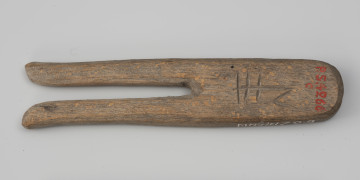
Buckle with ownership mark
1890 — 1950
National Museum in Szczecin
Part of the collection: Traditional fishing
The earliest nets were made from nettle fibres and linden phloem. Later on, flax and hemp began to be used, which are still used as a raw material for making nets and shorelines. Fishermen used to make their nets themselves and still often make individual parts of the nets today, especially in order to repair them. The netting-needle on display, which has a rather common form, is the only wooden netting-needle in the collection of the Pomeranian Department of Ethnography at the National Museum in Szczecin. It was probably made by the fisherman himself, who needed it, by simple planning. Finished with a spike on one side, the other has an oval eye for threading and grooves which, although they may have served to guide the threads, are more often thought to be ownership marks, similar to those found on fish net needles. The netting-needle, also known as a netting shuttle, served the same purpose as a fish net needle, specifically to mend the many holes in the nets, of which there were many after each catch. It was used in the 1st half of the 20th century by German fishermen from the island of Mönne (now Sadlińskie Łąki) on Lake Dąbie. It was acquired for the museum collection from the District Liquidation Office in Szczecin in 1948. Małgorzata Kłosińska-Grzechowiak
Other names
netting shuttle
Author / creator
Object type
needle, fishing tackle
Technique
planing, drilling
Material
wood
Origin / acquisition method
legal transfer
Creation time / dating
Creation / finding place
Owner
Muzeum Narodowe w Szczecinie
Identification number
Location / status

1890 — 1950
National Museum in Szczecin

1900 — 1950
National Museum in Szczecin

1900 — 1950
National Museum in Szczecin
DISCOVER this TOPIC
National Museum in Szczecin
DISCOVER this PATH
Educational path